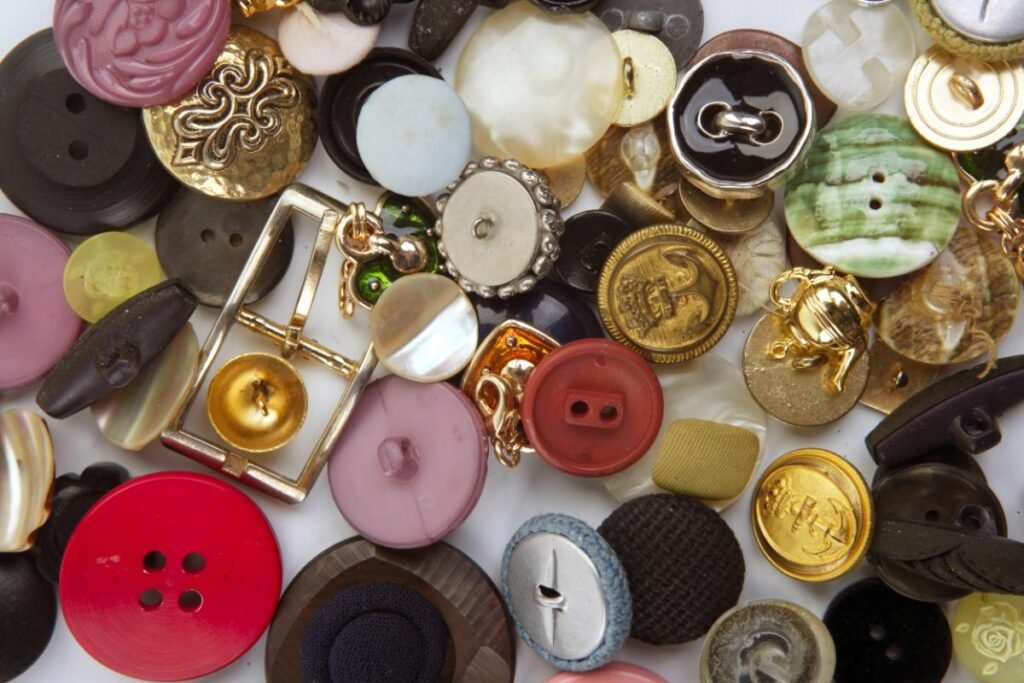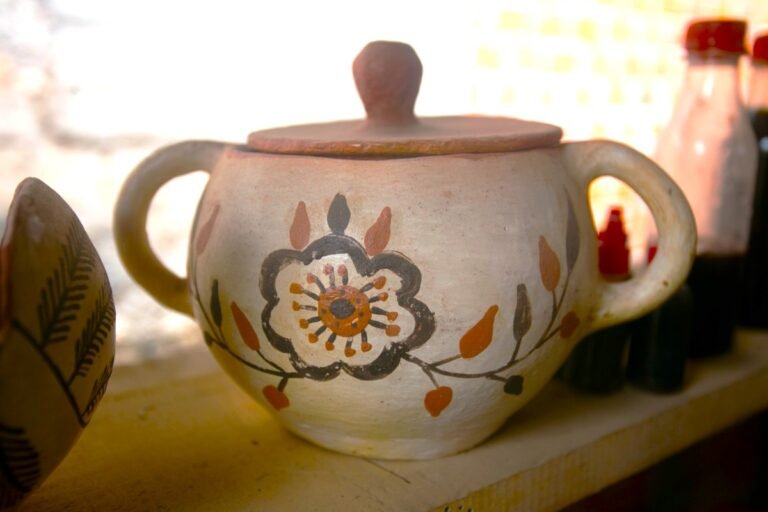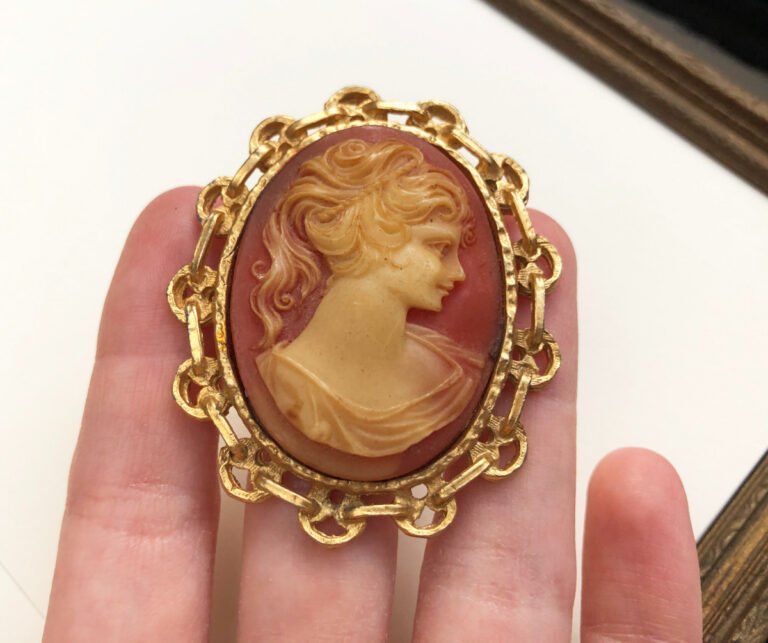Old buttons are something that is found in almost every home, yet most people don’t realize how fascinating these tiny accessories can be today. If you’re one of them, you’ve arrived at the right place.
In this guide, we will be exploring some easy ways to identify vintage buttons, understand what makes some rare and valuable, and learn how to know how much they could be worth!
A Brief about Old Antique Buttons
Buttons are ancient, but their creativity stood out only during the 18th century, when they were handmade. But not too long after, the Industrial Revolution led to the mass production of buttons in all sorts of materials, making them affordable.
Since then, many artistic forms of buttons have become popular. Be it prints of animals, flowers, or lovers’ portraits. They were even used as patriotic symbols during war, rallying spirits amongst people.
Though smaller than a dime, vintage buttons represent thousands of such stories. For generations, this has been a popular accessory, and even today it’s a highly anticipated antique piece. I am sure you got one too!
Quick Guide to Identify Vintage Buttons
Identifying and dating authentic antique vintage buttons needs a deep understanding of their composition, materials, and designs. But don’t worry, if you’re unfamiliar with these things!
Below are some crucial signs to find out whether an old button is really antique!
1. Materials
When learning how to spot a real vintage button, the first rule of thumb is to know its composition – is it porcelain, metal, glass, or another material? It can be a good dating clue. Here’s how:
Natural Materials:
- Wood buttons – Often used in the 1700s. These are lightweight with visible marks.
- Bone, horn, and ivory buttons – Common from the 17th through the 18th centuries for household purposes.
- Shell buttons – Known for their raw iridescence effect, popular in the pre-colonial times and from 1800 to 1870.
- Porcelain or ceramic buttons – One of the oldest natural forms.
- Gemstone-made buttons – Heavy and often well polished.
- Vegetable Ivory (tagua nut) – Common material for buttons during the 1860s to 1950s.
Synthetic Materials:
- Metallic buttons – Brass, pewter, silver, or gold, common in early times.
- Glass buttons – Fragile but very popular, especially in the Victorian period.
- Celluloid buttons – One of the earliest plastics, were mostly from the 1870s to the 1950s.
- Bakelite buttons – Started in 1907 and are collectible because of their durability.
There are other buttons made of rhinestone, lucite, resin, celluloid, pearl, and such, but their age can vary based on other features!
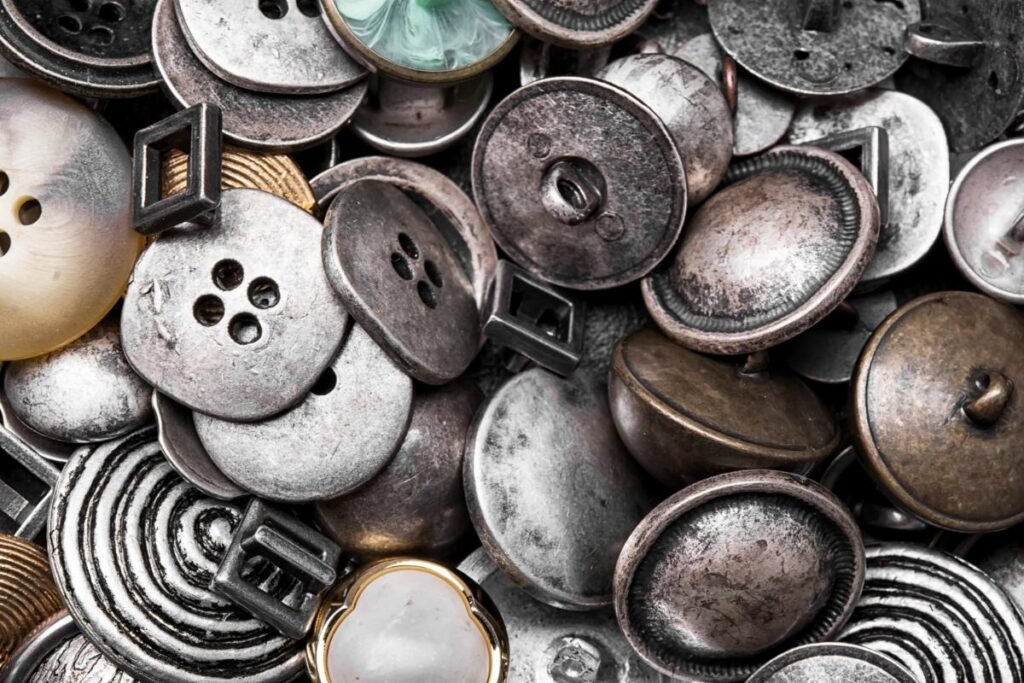
2. Manufacturing Techniques
You can easily identify authentic vintage buttons by their production style, as pieces from different eras vary because of how they were made.
Handmade Buttons:
Hand-carved buttons were predominant in the early 18th and 19th centuries. They are unique in shape, size and texture, lacking mold lines.
Machine-Made Buttons:
In the late 19th century, buttons were being produced with machines. So, they have uniform shapes and sizes, plus visible mold lines. These buttons, either on their edges or backs, show evidence of industrial production, like mechanical cutting signs and seam lines.
Mold Casting:
Craftsmen used to make buttons by pouring molten metal into button molds, which was a common technique from the 17th century to the mid-18th century. You can spot these by visible mold marks and seam lines on the back and around the eye/shank.
Stamped Buttons:
These buttons were made with thin, uniform metal discs (mostly brass) flattened by the stamping process. They were generally quite thin and had shanks separately soldered (not cast) onto the back. You will find clean and cutting marks on these.
Electroplating & Gilding:
Some vintage buttons may also have base metals like brass, copper, and steel that were electroplated with gold or silver to replicate the high-end look. Some examples may have marks for the same.
In some ceramic and porcelain pieces, you may also find elaborate gilding work.
3. Markings & Stamps
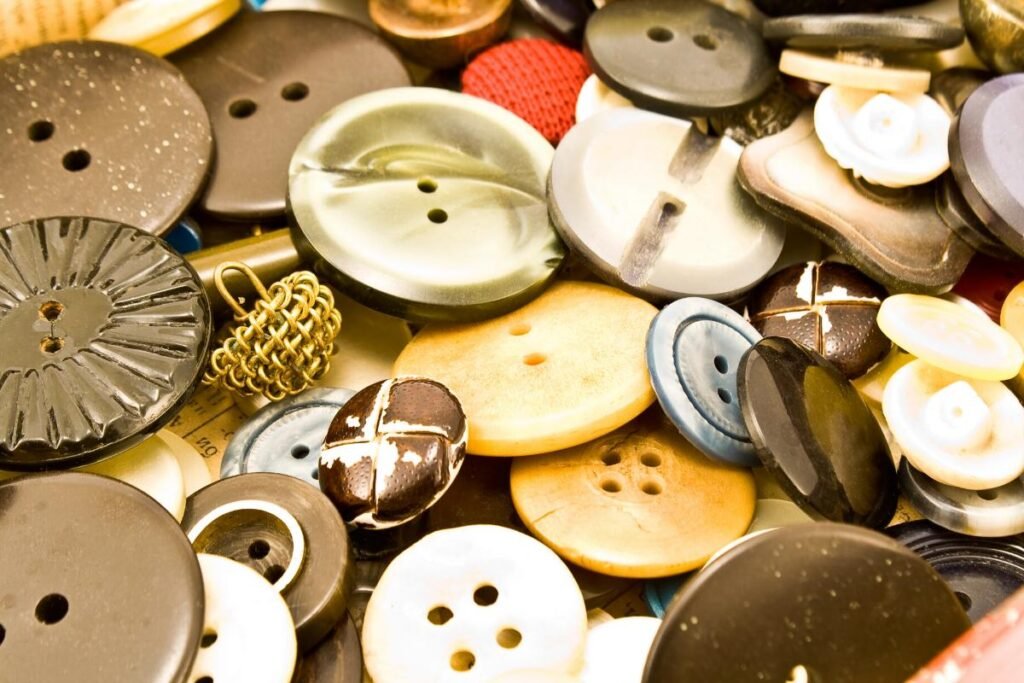
After the techniques, the next important sign to identify a rare vintage button is its markings. Marks and stamps can authenticate a lot of things, like its material purity, brand, and origin.
Generally, you will find the following types of marks on old buttons:
- Hallmarks – These are small stamps indicating the use of precious metal buttons, such as silver or gold. They confirm the authenticity of the buttons like “Sterling” or “925” for silver and “14K” for gold pieces.
- Manufacturer’s Marks – Buttons with the maker’s name, logo, and motto, often with a city or address, show authenticity. You may find these stamped or engraved on the back. (That’s why they’re also called backmarks)
- Patent Marks – Certain vintage buttons also show patent numbers, often found on the back, box, or packaging. This mark helps to confirm that a button is original and not a later reproduction. You may see marks like, “PAT’D 1888,” “PAT. NO. 123456,” and “PAT. PEND.” or “PAT. APPL’D FOR.”
- Unique Markings – Special buttons from the military or war may have initials or regiment symbols. U.S. buttons often feature a letter over the shield or within the design to indicate a branch.
4. Design Styles & Motifs
The design on old buttons reflects the artistic and cultural trends of its time, making it key to dating and identification. Here’s a quick guide to date a button based on the designs & motifs:
- The 1700s Pieces – These were mostly Baroque (or Rococo Baroque), that show floral patterns and geometric designs. People consider these styles luxurious because of their regal appearance.
- Victorian Era Buttons (1837-1901) – These mostly feature soft romantic motifs like ornate, pictorial, floral, and mythological figures. Since the buttons were hand-painted and tinted, collectors cherish them!
- Edwardian Buttons (1901-1910) – You’ll commonly find lacy filigree and delicate floral patterns on these pieces, mostly featuring pearls and shells.
- Art Nouveau Buttons (1890-1910) – Art Nouveau buttons are popular for their feminine and pretty artworks. You’ll find faces of women (camoes), butterflies, and nature-inspired curves.
- Art Deco Buttons (1920-1930) – Pieces from the 1920s-1930s were bold. They had geometric patterns like sunbarns, zigzags, pyramids, etc., and materials like bakelite. It’s still a high-end and minimalist piece.
- World War Era Buttons (1930-1940s) – During wartime, designs became modest. The military buttons featured insignia like the US Great Seal eagle, anchors, or state seals. People seek the war buttons as memorials!
6 Factors That Decide Vintage Buttons’ Value
Once you’ve figured out you got a REAL antique or vintage button, the next step is to find out whether it’s worth $10 or $100 or $1,000, or even more!
You can do so by analyzing the following factors:
1. The Matter of Age
Age plays a foundational role in determining an old button’s value. Collectors consider buttons that are at least 100 years old (pre-1925) as valuable antiques, while those from the early 20th century fall under the vintage category.
And generally, antique buttons fetch more premium prices than vintage or retro ones.
While you can use the above clues to date your piece, the following aging signs can also be of good help:
- Natural patina
- Discoloration in areas (especially on natural materials, like bone, shell, etc)
- Natural staining
- Softened backmarks or any other engraved details
- Fine crazing
- Yellowing on plastics
- Tool marks and irregularity (indicate hand-made production)
Be Careful: Some new buttons are made to look old on purpose. So, feel the texture. Authentic buttons may feel slightly rough or worn down in places, while fake signs feel smooth.
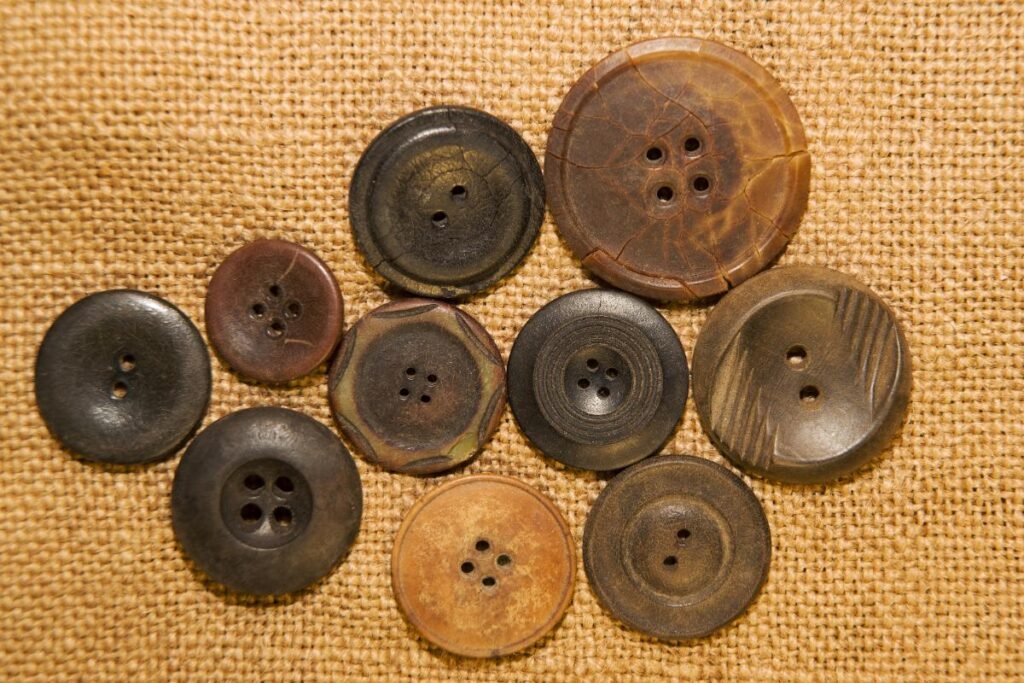
2. Rarity & Uniqueness
Like all old items, rarity can drastically impact the value of old buttons; the rarer the piece, the higher the worth.
Now, a vintage button becomes rare when it is made in limited quantities, uses unique materials, or serves a specific purpose.
Similarly, limited pieces created for special events, uniforms, or exclusive fashion lines of high-end brands, especially with handcrafting or artist-signed designs, are also rather rare today.
The use of rare techniques, like reverse painting and cut-steel mounting, can also make old buttons rare.
3. Condition
The condition of a button matters a lot in assessing its value. Pieces in excellent condition, free from chips, cracks, fading, or restoration, are significantly more valuable than those showing wear or damage.
Collectors keenly examine flaws that can affect the appearance and, hence worth of vintage buttons. So, you must also look for these conditions carefully:
- Cracks in glass, plastic or enamel
- Deep rust or corrosion in metal buttons
- Chips or missing fragments
- Warping, especially in celluloid or bakelite
- Broken shanks
- Poor restoration, like visible glue, paint mismatches
These signs are red flags and can seriously reduce an old button’s monetary value.
4. Completeness
There’s no doubt that people, especially collectors, love complete sets more than individual buttons. The more complete and original the collection, the greater the value.
The collection can be of the same buttons from the same garment, pieces from the same Manufacturer or line, or full uniform or costume sets.
5. Makers’ Reputation
The markings on vintage buttons not only help in identification, but also drive their value. A well-known maker’s mark can add a lot more value to an otherwise ordinary button.
Below are some highly renowned brands that collectors look for:
- Waterbury Button Company – Known for novelty designs with raised Insignia. You will find their marks as “Waterbury Conn.”, “WATERBURY BUTTON CO. CONN,” or just “Waterbury” on the buttons.
- Blumenthal and Company – A popular fashion-forward maker often featured intaglio glass with decorative design. Look for marks that say ”La Mode” and “Le Chic” to verify the original pieces.
- Harvey Chalmers & Son – known for their pearl buttons, often appear on them as “Bonnie Heather Pearls” printed in a scripted font. Their signature cards are themselves collectible, making their buttons valuable.
- N.S Neymar – A respectable maker associated with the US military, often marked their buttons as “NS NEYMER” or “N.S. Neymer” on the back. Sometimes the city, “New York”, appears beneath the name as well.
You can find these marks on the back side of the buttons, box provided, inside the top screw buttons, or any card attached to it.
6. Documentation & Provenance
Antique buttons with a verifiable history, such as having been owned by a famous person, used in a significant event, or part of a well-documented collection, are more attractive to collectors.
But you need something to prove the provenance. That’s why documentation, such as original packaging or box, receipts, labels, tags, sales receipts, or catalogs, is quite valuable.
12 Examples of Rare Antique Buttons Worth Money!
The following examples (based on real sales) will tell you how exactly the above factors impact the value of old buttons!
1. Iconic Victorian Picture Button

- Material: Brass
- Design: Kate Greenway’s Baby Sweetheart Art
- Color: Black and Golden
- Era: 1880-1910
Victorian vintage buttons from the 1830s to 1910s are among the most ornate and diverse pieces in button history. These pieces mostly feature the sweet faces of children, just like this classic example.
It shows renowned illustrator Kate Greenway’s artwork with two kids sitting in a boat. You’ll see finely engraved floral and vine motifs on the front and soldered shank on the back! Such rare metal buttons can fetch a thousand or more!
2. Vintage Wobble Shank Trouser Buttons

- Material: Metal
- Designs: Maker’s mark
- Color: Multiple
- Era: Early 1900s
Wobble shank buttons are those that have loosely attached shanks, letting the button pivot or “wobble.” Antique metal pieces of this type in good condition can be worth a small fortune today.
These types were made to reduce stress on the fabric and prevent wear. People often used them on heavier garments like coats and uniforms in the late 19th to early 20th century.
3. Vintage Gucci Sterling Enamel Buttons
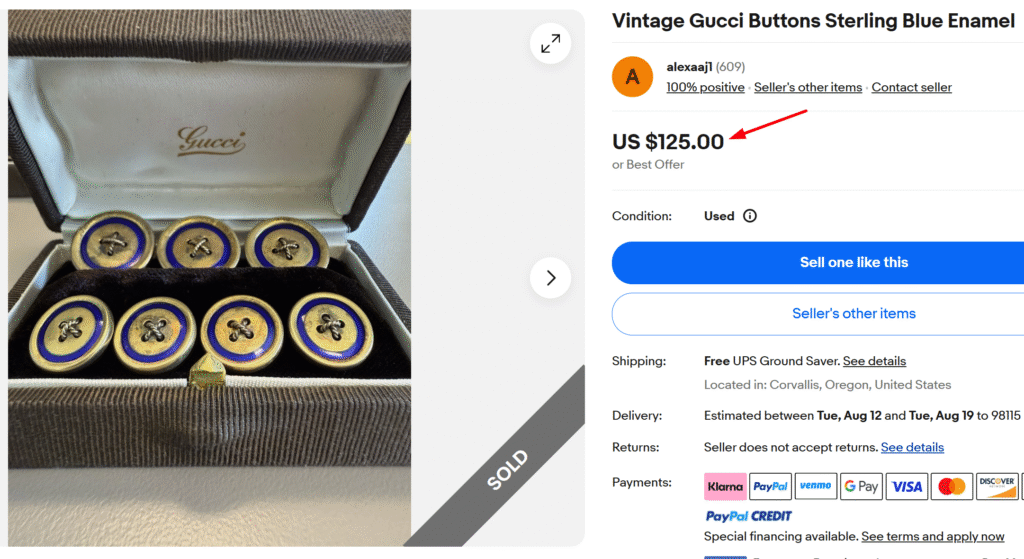
- Material: Sterling Silver & Enamel
- Design: Simple enamel work
- Color: Blue on Golden
- Estimated Era: 1930s onwards
Gucci’s vintage enamel buttons, made from the 1930s to the early 1990s are now luxury fashion accents. When designer branding became prominent later, the buttons often featured the classic Gucci logo or equestrian motifs.
Some pieces might also feature ‘Gucci Italy’ marked on them. Since this is a complete set from the same garment, and with a proper box, it sold for a decent price of over $120!
4. Revolutionary War USA Officer Pewter Coat Button

- Material: Mold Metal
- Design: Militaria
- Color: Navy Blue
- Estimated Era: 1775-1783
This ancient pewter military button from the Revolutionary War in 1775 is a collector’s dream. It bears unique hallmark design motifs (too worn out to recognize) from the era, making it a valuable artifact from the USA.
The natural aging and its historical significance are what gave this rare piece a stunning value.
5. Vintage Porcelain Satsuma Buttons
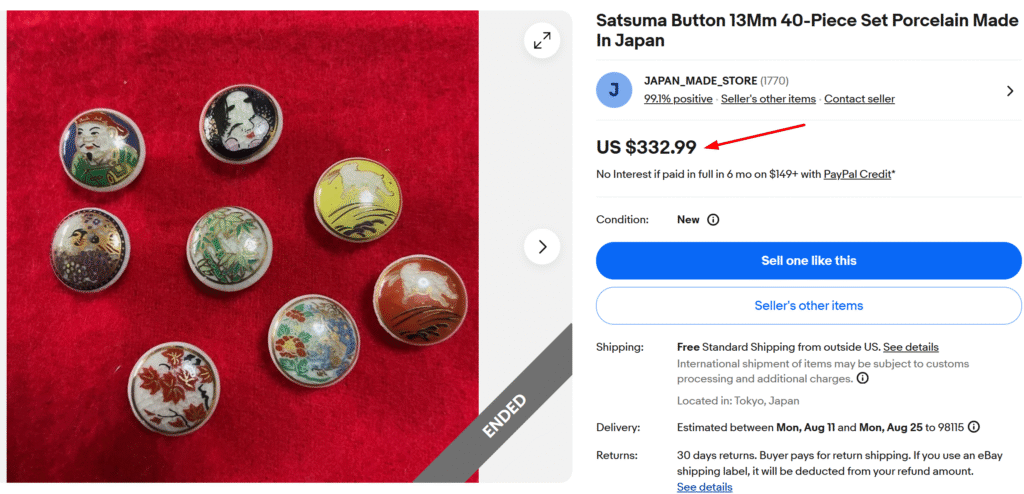
- Material: Porcelian
- Color: Multiple
- Design: Sakura
- Era: 1930s-1950s
A Japanese masterpiece, sakura artwork buttons, were exported to the West as cultural symbols. “Sakura” means cherry blossom in Japanese, so these buttons often feature hand-painted cherry blossom motifs as well as other vibrant designs. Large sets of fine pieces can be worth $150-$500!
6. Antique 1920s Portuguese Buttons

- Material: Plaster of Paris
- Color: Multiple
- Design: Portuguese cultural symbols
- Era: 1920s
These beautiful thematic buttons are a perfect reflection of Portuguese culture. Their designs are highly figurative and whimsical. As it is handcrafted and painted, buttons like these are highly sought for their rare folk art.
This collection was presented and signed by the well-known collector Diana Epstein, the owner of Tender Buttons NYC, in 1979.
7. Victorian Turquoise Blue Gold Painted Glass Buttons
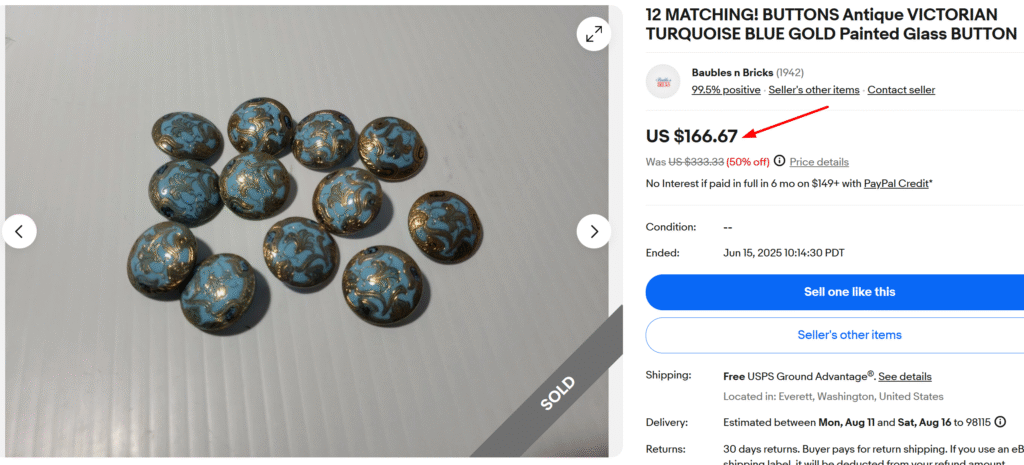
- Material: Brass
- Color: Blue and Gold
- Design: Flower
- Era: 1930s
These Victorian brass buttons from the early 1900s indicate the artistic work from that period. With hand-painted floral patterns in turquoise blue and gold, the pieces also have loop shanks at the back.
Antique metal buttons with such elaborate art, like engraved designs and painting, are highly desirable. Based on condition and number of pieces, they can be worth $80 to $200+!
8. Vintage Glass Calico Buttons
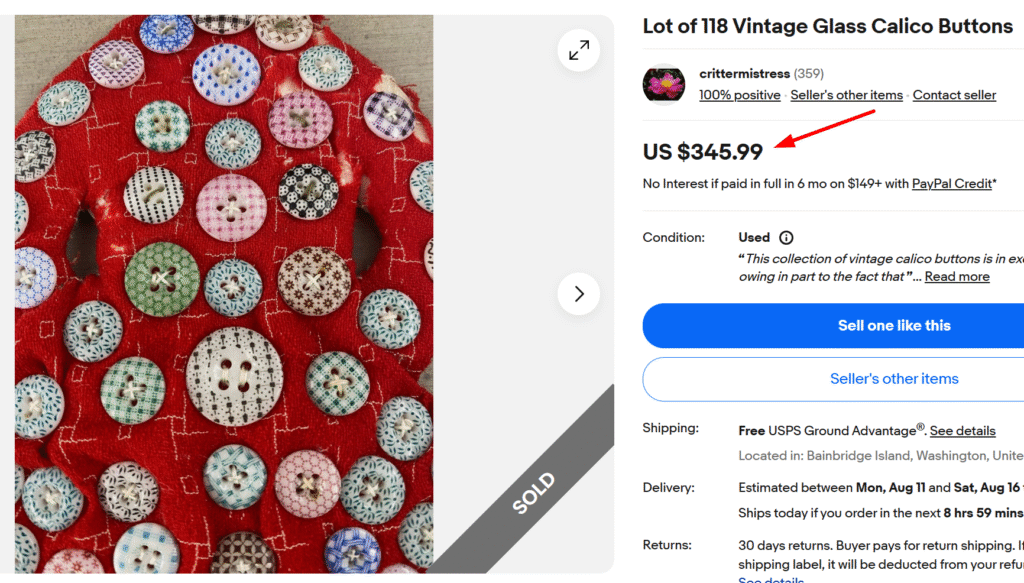
- Material: Ceramic
- Design: Calico
- Color: Multicolour with white base
- Era: 1940s
Just like the name hints, these buttons were made to match the iconic plain, crisscross Callico fabric. The designs usually have floral or geometric calico prints. These buttons were first produced in England by Minton and Prosser in the 1940s, and are highly prized today for their handmade charm.
9. Vintage Italian Micro Mosaic Art Glass Buttons
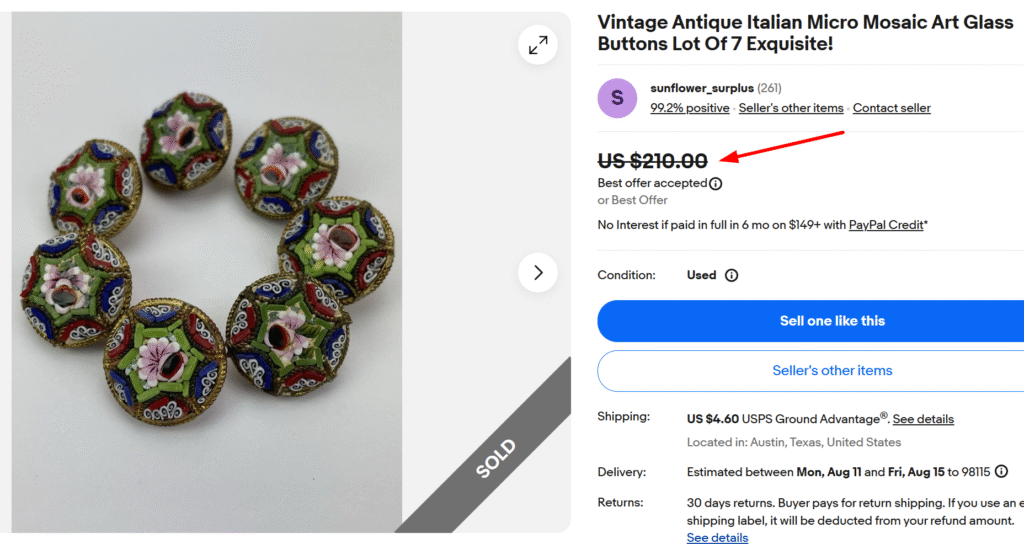
- Material: Art Glass
- Design: Floral
- Color: Blue, Green, Red & Pink
- Era: 1900s onwards
This is an exquisite collection of micro-mosaic art glass buttons produced in the Czech Republic. Mosaic glass buttons are common, but the most famous are the micro mosaic ones (tiny glass tesserae set into metal), where colorful rods of glass are fused and sliced to reveal flower-like cross-sections.
These are completely handmade and may have imperfections like tiny bubbles and signs of wear, which make them unique.
10. Vintage 22K Gold Cufflink Buttons
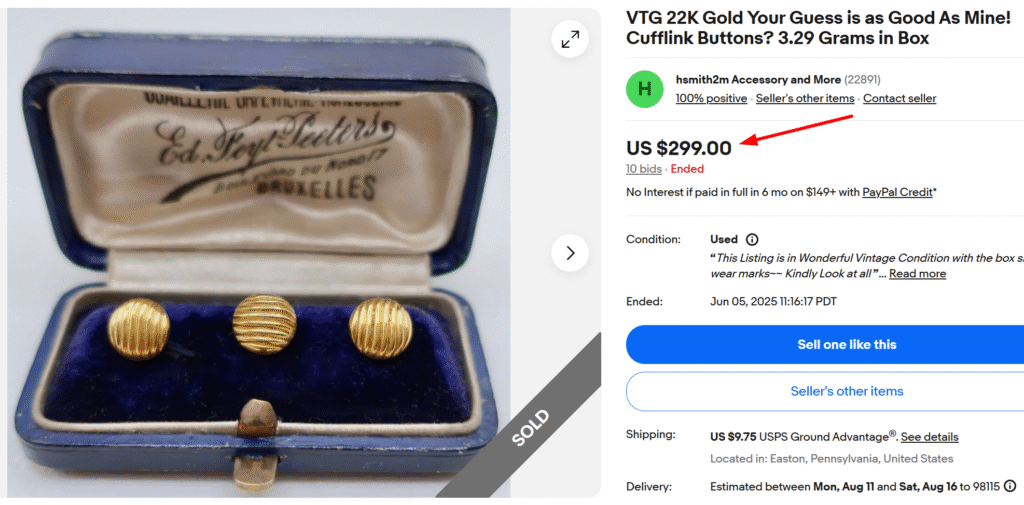
- Material: 22k Gold
- Design: Simple ribbed pattern
- Color: Golden
- Era: Pre-1930s
Gold vintage buttons, often crafted from gold-plated brass or metal alloys, enjoyed popularity in the Victorian era. This is a set of golden cufflink buttons, a men’s accessory that adorns high-fashion garments, uniforms, and designer coats.
This set is from “Ed. Toyt Peeters,” a known Los Angeles jeweler of that time. The well-kept box with clear branding made this set worth the price tag of $300!
11. Vintage Taxco Silver Buttons

- Material: Silver
- Design: Beaded border
- Color: Silver
- Era: 1930s to 1950s
These vintage buttons from Taxco, Mexico, are made of authentic silver with 980/1000 purity! These buttons embody the rich tradition of artisanal work, featuring a detailed rope-like border design. Highly valuable due to their silver content!
My Tip: Don’t forget to look for purity hallmarks on buttons made of silver or gold.
12. Colt Plastic Cameo Rouge Button
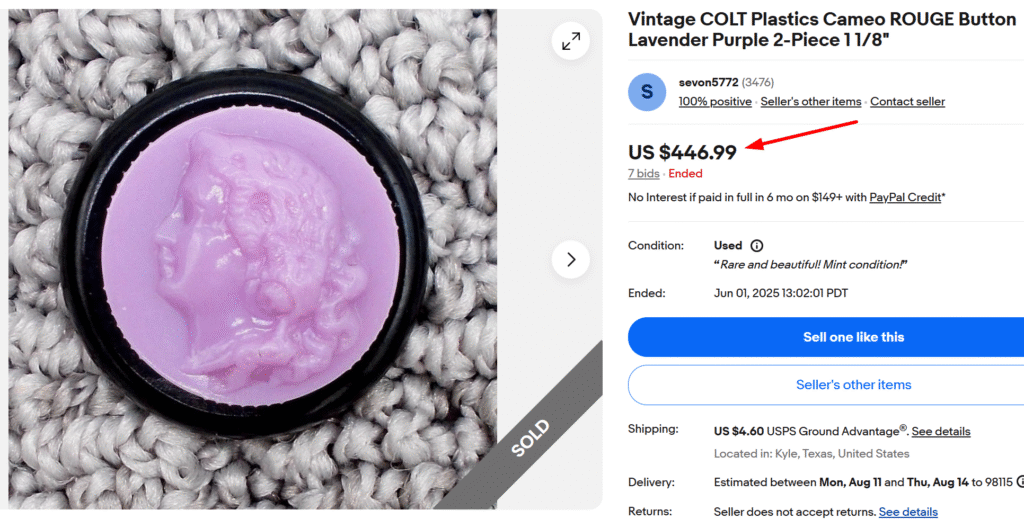
- Material: Plastic
- Design: Cameo rouge
- Color: Purple
- Era: Post 1950s
This vintage button featuring a high-relief cameo of a lady in lavender is from a prominent American manufacturer, Colt Plastics Company. Their collections represent quality designs of figurines, novelties, and abstracts.
These buttons are often self-shanked and have a screw top (meaning two pieces), under which you will find the “COLT” marking. Due to its ornate cameo, this piece sold for almost $450, despite being plastic.
Now that you know what a real vintage button is, I’m sure you can easily spot a rare piece in your own collection or from a large lot at a flea market! But remember to check the important details, because sometimes even new pieces can look old!

